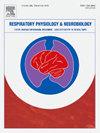慢速深呼吸变化技术对通气能力和吸气肌耐力的急性影响
IF 1.6
4区 医学
Q3 PHYSIOLOGY
引用次数: 0
摘要
目的探讨深呼吸热身技术对大鼠通气量和吸气肌耐力的影响。方法在随机交叉设计中,14名运动女性进行了4种不同的吸气肌热身(IMW)方案,随后进行了最大自主通气(MVV)和重复吸气阻力呼吸(RIRB)测试。在IMW前后也监测心率变异性。IMW技术包括深吸气加正常呼气(DI)、深吸气加短屏气(DI- h)、深吸气加短屏气后浅呼吸交替(DI- h /SB)、深吸气加呼气(DI- de)。每组进行6个呼吸循环,共5组,每组之间休息1分钟。结果两种屏气方案患者smvv和RIRB评分均显著升高(MVV: p = 0.002,p = 0.021;RIRB p = 0.002,p = 0.002,分别在DI-H和DI-H/SB中)。仅仅是深刻的灵感并不能影响这两个参数。另一方面,缓慢深吸气和深呼气增加了RIRB尝试次数(p = 0.020),但对MVV值没有影响。心电图显示,短时间连续屏气深度吸气组(p = 0.043)和慢时间深度吸气深度呼气组(p = 0.032)RMSSD心率变异性显著降低。然而,深/浅交替呼吸技术没有观察到下降。结论在IMW过程中增加短时间屏气对吸气肌施加了显著的压力,从而激活了更高的疲劳耐受性。深/浅交替呼吸有助于减轻因屏气而产生的压力。本文章由计算机程序翻译,如有差异,请以英文原文为准。
The acute effect of slow deep breathing variation techniques on ventilatory capacity and inspiratory muscle endurance
Objectives
The study aimed to examine the post-effect of deep breathing warm-up techniques on ventilatory capacity and inspiratory muscle endurance.
Methods
In a randomized crossover design, fourteen active women performed four different inspiratory muscle warm-up (IMW) protocols followed by maximum voluntary ventilation (MVV) and repeated inspiratory resistance breathing (RIRB) tests. Heart rate variability was also monitored before and after IMW. IMW techniques included deep inspiration with normal expiration (DI), deep inspiration with short breath-holding (DI-H), deep inspiration with short breath-holding followed by shallow breathing alternate (DI-H/SB), and deep inspiration and expiration (DI-DE). Each protocol was performed six breathing cycles per set for five sets, one-minute rest between sets.
Results
MVV and RIRB score were significantly increased by both protocols with breath-holding (MVV: p = 0.002, p = 0.021; RIRB p = 0.002, p = 0.002, in DI-H and DI-H/SB, respectively). Deep inspiration alone did not affect both parameters. On the other hand, slow deep inspiration and deep expiration increased RIRB attempts (p = 0.020) without any effect on MVV value. Electrocardiogram indicated a significant decrease in RMSSD heart rate variability in deep inspiration with short breath-holding continuously (p = 0.043) and slow deep inspiration and deep expiration techniques (p = 0.032). However, a decrease was not observed in the technique of deep/shallow breathing alternate.
Conclusion
The data suggested that the addition of short breath-holding during IMW exerted significant stress on inspiratory muscles, which consequently activated a higher tolerance to fatigue. Deep/shallow alternate breathing helped lessen the stress due to breath-holding.
求助全文
通过发布文献求助,成功后即可免费获取论文全文。
去求助
来源期刊
CiteScore
4.80
自引率
8.70%
发文量
104
审稿时长
54 days
期刊介绍:
Respiratory Physiology & Neurobiology (RESPNB) publishes original articles and invited reviews concerning physiology and pathophysiology of respiration in its broadest sense.
Although a special focus is on topics in neurobiology, high quality papers in respiratory molecular and cellular biology are also welcome, as are high-quality papers in traditional areas, such as:
-Mechanics of breathing-
Gas exchange and acid-base balance-
Respiration at rest and exercise-
Respiration in unusual conditions, like high or low pressure or changes of temperature, low ambient oxygen-
Embryonic and adult respiration-
Comparative respiratory physiology.
Papers on clinical aspects, original methods, as well as theoretical papers are also considered as long as they foster the understanding of respiratory physiology and pathophysiology.

 求助内容:
求助内容: 应助结果提醒方式:
应助结果提醒方式:


